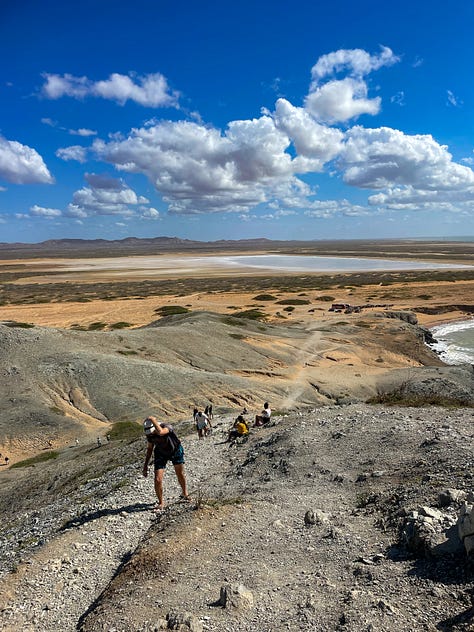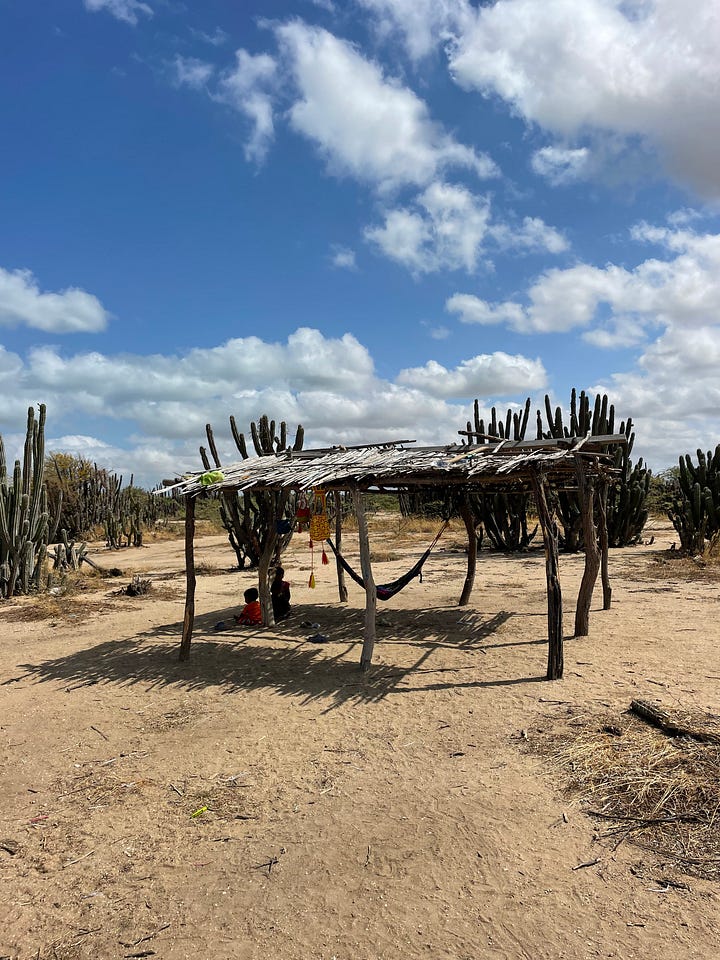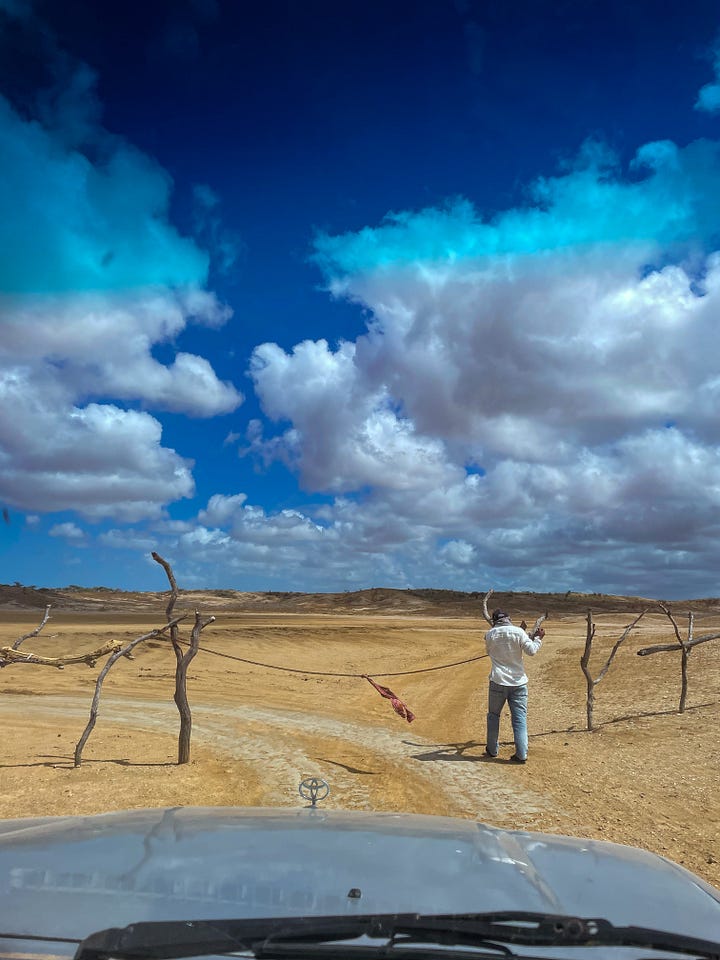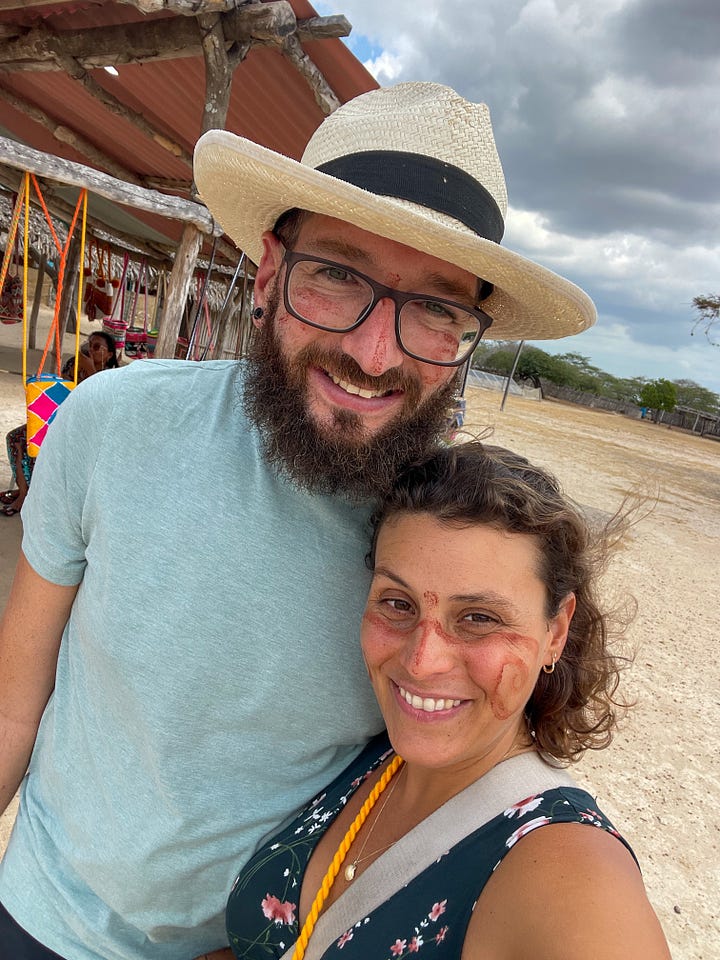What we learned from the Wayuu people
Journal Entry #11: February 20th 2023, Hiking to La Ciudad Perdida Colombia
Hola and welcome to Where on Planet Earth! In case you got here by accident and are not yet a subscriber, sign up below! For more visuals on our travels please follow us on IG @whereonplanetearth
We are on our first day of a four-day hike into la Ciudad Perdida, literally a lost city of the Tayrona, the indigenous group who used to inhabit this area before the Spaniards arrived and practically decimated them. Before that we spent five days on a gorgeous Airbnb on the outskirts of Tayrona National Park, going on walks through the lush jungle and into wild beaches. But before all of that, we went to La Guajira, a dry and isolated peninsula on the border with Venezuela, and that unique experience is what I want to share about today.
La Guajira is a peninsula between Colombia and Venezuela, but truly it mostly belongs to the Wayuu, who make more than 50% of the population in it. In the Alta Guajira - the northermost area - they are the vast majority. The Wayuu people are the largest indigenous group of both Venezuela and Colombia. I wanted to visit the peninsula to see its landscape, as it promised to be more remote than anything else on this coast, but also because I wanted to meet and learn from the Wayuu, a population I had heard about in Venezuela but truly knew very little about.


Visiting la Alta Guajira on your own is difficult due to the road conditions (there aren’t any!) and many unspoken rules, so most opt for an organized tour, which is what we did. We spent 4 days in the peninsula, drove for most hours of each day, and still only saw a small portion of it. It’s giant, remote, and rough.
It’s a landscape of contrasts; bright orange dunes next to aquamarine bays, long wild sandy beaches next to miles and miles of flat dry desert, goats eating from a little branch with a plastic bag caught in it. No roads, just dozens of tire marks going this way and that. Those who live and work here navigate the landscape like an imprint on their minds.






There is a lot about this place I want to share. Too much really, to put into a journal post. So, for now, let me tell you about the Wayuu people.
The Wayuu people have lived in this area for thousands of years. They were never subjugated and their land was never taken by anyone, although not for lack of trying. The Spanish tried to conquer them but never could, partly because the Wayuu were the only indigenous group in Colombia who learned how to use guns and horses, so them and the Spanish simply remained in a perpetual state of war for hundreds of years.
Now, they are close to 800,000 Wayuu people living in Colombia and Venezuela. An early 2000s census found that the majority of the Wayuu population were in Venezuela, but a lot has changed since then and many have fled or return to Colombia due to the political situation in Venezuela. The likelihood is that those numbers have sifted significantly. The Guajira region itself is sort of country-less, the Wayuu who are born there might or might not be registered in either country and some have dual citizenship. Movement between the two countries, in search of work or better weather during a specific season, are common, but so are disputes over land.




On our last day in La Guajira we visited one of the thousands of Wayuu communities in the area, called Rancherias. There, we spent a couple hours chatting with Vanessa, a community leader, who shared a lot about their way of living and let us ask her all our questions. Here is some of what we learned.
“El eje fundamental de la cultura Wayuu es la mujer Wayuu”
”The fundamental axis of the Wayuu culture is the Wayuu woman”
Wayuu culture is matrilinial, which means mothers - and only mothers - can make someone a Wayuu. It’s the same for Judaism. If your mom is not Wayuu, then you are not Wayuu. This is why girl births are celebrated and desired, as they are the ones who can continue to expand the Wayuu family. The Wayuu don’t celebrate birthdays, anniversaries, or the New Year, but they celebrate the birth of a girl. They also celebrate a good crop, heavy rains after a drought, and someone sick being cured. Their celebration dance is called Chichamaya or Yonna and starts with the sound of a kasha, similar to a drum. Anyone who hears the kasha is invited to the Yonna, so they never really know how many people will show up! In their traditional dance the woman chases the man until he falls down. There are many dance steps, and most of them mimic animals: ants, vultures, flies, etc.
An important foundation of the Wayuu culture is regarding reparations and compensations. Basically, any wrongdoing must be compensated in some way, usually with spices, goats, donkeys, necklaces, and nowdays, money. The entire family is responsible for any wrongdoing, not only the person who inflicted it. Even the most serious crimes are compensated, since no jail exist here. This system is enforced by the Pütchipü’üi or Palabrero, which roughly translates to ‘the one who carries the word’, who are experts in resolving conflicts between people and clans through negotiation and mediation. This legislative system was even recognized by UNESCO as part of the Intangible Cultural Heritage of Humanity, and also by the governments of Venezuela and Colombia.
This reparations system is divided into many laws such as the “law of payment for theft”, and the “law for pain caused and blood spilled”. Even if you are doing someone a favor or providing a service you are ultimately responsible for compensating them if something goes wrong. For example, if you give someone a ride and you get into an accident, that would fall under the “law for pain caused and blood spilled” and you would owe compensation to the person you gave the ride to.
As we drove through the peninsula we were asked for rides on many occasions, but because we had a packed car I didn’t think twice about how our driver Pocho quickly turned them down. That is, until he said “even if I had a spot, I would not give them a ride”. Pocho was scared to get into an accident and then owe compensation. We also learned that not many years ago many doctors refused to treat Wayuu people because of this law. They were scared to treat someone and that person dying or not getting better, as they would also owe reparations. Nowdays it seems the situation has improved in this regards, but still, our driver wouldn’t give any rides.
Tourism started arriving in the region around 40 years ago due to Maicao, a city in the Peninsula and a contraband heaven. People would go there to buy something and then wonder what else they could see around the area. So, tourism developed, and with it hundreds of makeshift roadblocks started popping up all around the peninsula. We had to stop in at least 50 of them; a motorcycle chain stuck in between two sticks, a simple yet very effective to make people stop. Old men, children with toddlers in their arms, pregnant women, they all stand next to these roadblocks with their hands stretched out. Children expect a small bag of cookies, women and men a bag of coffee or a panela (brown sugar block). “It’s not always the same”, our driver Pocho tells us, “we switch it up, anything non perishable is well received”. Some of the people say thank you, some ask for more or for specific things like water which is quite scarce in the peninsula, some remain emotionless and take what is given with entitlement. After all, this is their land, and this has become their rule.
Vanessa, and many others like her, now live off tourism. But still, she is quick to point out that not all tourism effects are positive. “The roadblocks have been a negative effect of tourism”, she told us, “we didn’t use to be beggars, but what can you do now?”
At the end, I am not sure I’d recommend visiting the region unless you have lots of time on the coast or are really into deserts, but I am really glad we went. We learned a lot about the Wayuu culture, and also about ourselves. Ultimately, that is why we travel <3




Here are a few other interesting facts about the Wayuu culture:
After a girl has her first menstruation she goes through a confinement period which used to last years but can now be from one week to a maximum of one year. During this time the girl can’t consume sugar, salt, or fat, and the objective is for her to learn the meaning of being a woman, as well as the value and wisdom of Wayuu woman, through spending time with her mother and grandmothers.
The wake/burial is the most important event for the Wayuu. It’s celebrated in a big way, and as many other cultures they bury their loved ones with their favorite food and drink so they can enjoy in their second life. After four years or more there is a second wake, in which the remains are removed from the ground. Sometimes they take the remains away to be buried somewhere else, sometimes not. In both wakes the family that is holding it has to pay a goat to each family that goes to the wake, to basically compensate them for their tears.
Families in the Wayuu culture are divided into clans, identified by animals and each with a traditional leader, who can be female or male and is chosen by the descendants of the first Wayuu who claimed the land they live on. They paint their faces with different shapes depending on their clan. Women always have spiral shapes because everything revolves around them. They do this with the root of a tree and the paint is red.
To get married, the man asks the woman, but not directly. First he asks his own family, and if they approve they ask her family through the Palabrero. Then, her family will ask her and they will decide together. There is no obligation to say yes.
Some of the Wayuu paint their faces completely black with a mix of a native mushroom combines with goat fat. This is their natural sunscreen!






A goat to EACH family sounds very expensive!
Enjoy the Ciudad Perdida hike, it was a highlight for me back when I visited.